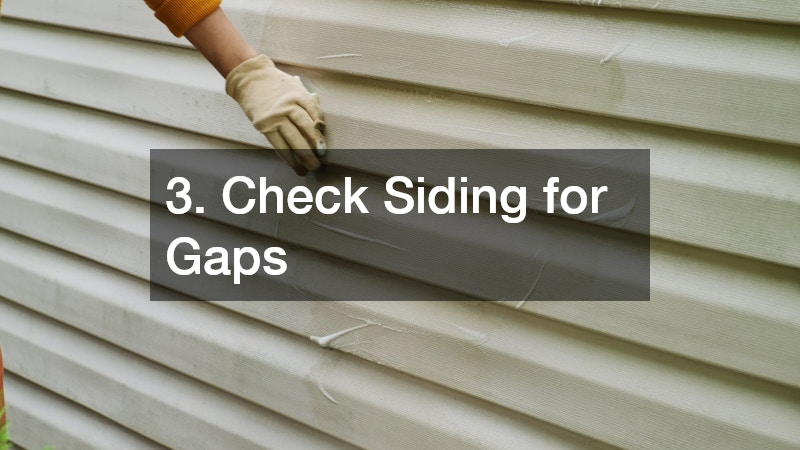Drafts can make a home feel uncomfortable even when the heating system is running at full capacity. Many homeowners don’t realize how much cold air can enter through small cracks, poorly sealed openings, or aging structural components. These leaks not only chill indoor spaces but also force heating systems to work harder, increasing utility bills and reducing long-term energy efficiency. Unlike obvious gaps or visible damage, hidden drafts often come from subtle issues that require attention, investigation, and some preventive maintenance. Learning how to spot these trouble spots—both inside and outside the home—can make a significant difference in warmth and comfort throughout the colder months.
This guide explains the most effective ways to locate hidden drafts, strengthen insulation, and maintain warmth. With attention to detail, routine checks, and smart solutions that improve every layer of your home’s envelope, you can ensure energy efficiency and long-term comfort. Whether you’re preparing for winter or addressing ongoing temperature inconsistencies, these steps will help you create a warmer, more efficient home that’s enjoyable year-round.
1. Inspect Windows for Subtle Air Leaks

Windows are one of the most common sources of hidden drafts, especially when seals wear down or frames shift over time. Cold air can seep in through microscopic cracks around the glass, frame edges, or caulking. Homeowners can perform a simple draft test by running a hand along window edges on a windy day, using a lit candle to detect air movement, or examining weatherstripping for deterioration. If the heating system seems to run constantly or certain rooms feel chillier despite closed windows, subtle leaks are often the cause. Addressing these areas early prevents heat loss and improves the overall comfort of your home.
Professional guidance is particularly helpful when windows show signs of aging or structural gaps. Many homeowners also turn to hurricane windows and doors companies for stronger, airtight window systems that improve insulation while adding protection from extreme weather. These specialists can recommend upgrades, evaluate seals, and ensure windows are properly aligned and secured. By improving window performance, homeowners can dramatically reduce cold drafts year-round.
Another way to enhance insulation is by installing window blinds with thicker, energy-efficient materials. This creates a barrier that slows heat transfer and helps block drafts on extremely cold days. Heavy fabrics, cellular designs, or layered coverings increase insulation and help make rooms feel more stable in temperature, especially overnight.
2. Examine Doors and Sliding Entries for Air Infiltration
Doors, especially older or frequently used ones, can develop gaps that allow cold air to enter. Exterior doors can shift over time due to seasonal temperature changes, foundation movement, or worn hinges. Drafts often appear beneath the door sweep or around the frame, and these leaks can be surprisingly powerful on windy days. Homeowners can use weatherstripping, draft stoppers, or threshold adjustments to minimize airflow. Ensuring that exterior doors are properly sealed improves warmth and reduces strain on your heating system.
Garage doors are another major source of heat loss, particularly when gaps exist along the edges or bottom. Maintaining overhead garage doors is essential for preventing drafts from entering the home through connected spaces like utility rooms or entryways. Regular inspections of tracks, seals, and panels help ensure that the door closes tightly and provides a protective barrier against cold air.
Another often overlooked opening is a home’s sliding glass entry. Cold air can enter through worn tracks, bent frames, or missing weatherstripping. Scheduling sliding door repair helps ensure the door glides smoothly, seals properly, and keeps cold air outside. Technicians can also realign the frame or replace damaged components to restore full insulation and functionality.
Homeowners with attached garages can also benefit from consulting garage door contractors for more complex repairs or replacements. These professionals can assess insulation, replace outdated systems, and recommend solutions that prevent heat loss through large garage openings. Improved garage door performance contributes directly to better home temperature regulation during winter.
3. Check Siding for Gaps

Exterior siding plays a crucial role in sealing the home’s envelope. Over time, siding can loosen, crack, or pull away from the framing, creating small openings that allow cold air to infiltrate. These gaps may be difficult to see from a distance but can lead to significant heat loss when left unaddressed. Regularly walking around your home and inspecting siding panels for damage, separation, or warping ensures you spot issues early. Repairing small gaps prevents bigger structural and energy-related problems later.
Consulting professional siding contractors can help homeowners identify hidden leaks behind siding, evaluate moisture damage, and recommend necessary repairs. Their expertise ensures that siding remains durable, weather-resistant, and tightly sealed against outdoor temperatures. Professional evaluation is especially useful for older homes or properties exposed to strong seasonal winds.
When siding damage is more extensive, full replacement may be needed. Professional siding installation services ensure that new materials are installed tightly, aligned correctly, and sealed against drafts. Proper installation preserves energy efficiency, enhances curb appeal, and adds long-term protection against weather-related issues such as moisture, pests, and cold air leaks.
4. Inspect Your Roof for Hidden Openings
Roofs often develop subtle vulnerabilities that allow cold air into attic spaces, which then transfer chilly air through ceilings and vents. Loose shingles, gaps in flashing, aging sealants, or damaged underlayment can compromise insulation. Homeowners can look for visible signs such as missing shingles, sagging areas, or water stains inside the home. Attic insulation also plays an important role, and uneven settling or deterioration can increase heat loss dramatically. Ensuring proper insulation depth and coverage helps maintain consistent interior temperatures.
Arranging professional roof inspections allows experts to identify leaks, ventilation issues, and insulation concerns that the average homeowner may miss. Comprehensive inspection reports help you understand which repairs are necessary to maintain a warm, secure home during cold months. Proactive roof maintenance is one of the most effective ways to prevent long-term energy loss.
Before beginning repairs, homeowners may choose to request local roof estimates to compare pricing, materials, and recommended solutions. This step ensures transparency, helps budget for necessary improvements, and provides confidence in the work being performed. Even minor roof adjustments can significantly improve your home’s insulation and overall comfort.
5. Strengthen Insulation and Interior Comfort Layers
Interior insulation plays an essential role in preventing drafts, but even high-quality insulation can degrade over time. Gaps may form around electrical outlets, baseboards, attic access panels, and recessed lighting fixtures. Cold air can also enter through crawl spaces or poorly sealed basement joints. Homeowners can inspect these areas closely and use expanding foam or weatherproof caulking to fill small cracks. Ensuring walls, ceilings, and floors are properly insulated contributes greatly to overall warmth.
Window treatments offer another interior solution for improving insulation. Installing window blinds with dense or thermal materials adds a protective buffer that helps keep warm air inside. Closing blinds at night, especially during extreme cold spells, reduces draft effects and supports a more stable indoor climate.
Additional thermal protection comes from residential window tinting, which helps balance temperature loss and reduces cold spots around window glass. Tinting can be part of a larger insulation strategy that enhances comfort and improves HVAC efficiency while keeping the home naturally brighter than heavy window coverings alone.
6. Evaluate Air Flow Around Large Openings and Utility Areas

Large home openings—such as patio doors, garage entryways, or utility room passages—are prone to drafts due to frequent use and wide surface areas. Homeowners should check door sweeps, thresholds, and weatherstripping regularly. Even small adjustments can significantly reduce heat loss. Over time, hinges, tracks, and locking mechanisms can wear down, creating alignment issues that allow drafts to form.
Addressing large openings often requires attention from trained professionals. Maintaining overhead garage doors ensures that panels, seals, and tracks function correctly. Because garage areas link directly to interior living spaces in many homes, proper sealing can greatly impact warmth and indoor comfort.
Schedule professional evaluation when needed through garage door contractors, who can provide maintenance, replacements, or upgrades that enhance insulation. Improved garage door performance helps block cold air at one of the largest entry points to the home.
Sliding entries in particular need ongoing maintenance to stay draft-free. Calling for sliding door repair when frames shift or seals deteriorate helps preserve warm air and prevent cold infiltration. Seasonal adjustments help doors close tightly and operate smoothly.
7. Improve Exterior Protection and Structural Integrity
A home’s exterior envelope must be strong to effectively resist cold weather and keep drafts at bay. Cracks in foundation walls, gaps around piping, or damaged trim can allow cold air to travel inside. Inspecting these areas seasonally helps ensure long-term durability. Small structural repairs, caulking, or sealing efforts can dramatically improve comfort during cold seasons.
Siding issues also impact heat retention. Professional evaluation from siding contractors helps uncover hidden problems such as gaps behind panels, moisture damage, or deteriorated fasteners. Comprehensive siding repairs keep the home sealed and improve energy efficiency.
Where siding damage is more significant, full replacement may be the better option. Using siding installation services ensures that materials are securely attached and provide optimal protection against cold air. Effective siding contributes to both structural integrity and indoor warmth, helping homeowners avoid costly heating bills.
8. Address Drafts from Rooftops, Attics, and Upper Floors

Upper sections of the home, including attic spaces, play a significant role in controlling heat transfer. Warm air naturally rises, so any gaps or vulnerabilities in the attic allow heat to escape quickly. Homeowners should check insulation depth and consistency, weatherstripping around attic doors, and ventilation systems that may be misaligned or cracked. Ensuring a tight attic seal helps maintain balanced indoor temperature.
Having periodic roof inspections helps identify potential weaknesses that allow cold air into attic spaces. Missing shingles, loose flashing, or aged sealants can allow outside air to circulate through upper levels. Repairing these issues before winter dramatically improves home comfort.
Before scheduling repairs, homeowners can obtain local roof estimates to ensure transparency and cost-effective planning. Comparing recommendations and pricing helps you make informed decisions and invest in long-lasting roof improvements that support warmth and energy efficiency.
9. Strengthen Indoor Warmth with Updated Interior Features
Indoor features such as flooring transitions, ventilation grilles, and wall openings can also allow cold air to circulate if improperly sealed. Homeowners should check window trim, replace worn weatherstripping, and examine areas behind large furniture where drafts can form. Interior insulation improvements contribute directly to comfort and energy savings during cold weather.
Window coverings also play a major role in interior comfort. Installing window blinds that provide thermal protection helps reduce cold spots near windows and improves insulation during winter nights. Layered window treatments can further enhance warmth and reduce heating load.
For additional energy control and comfort, homeowners may consider residential window tinting as a supplemental insulation measure. Tinting helps regulate heat transfer around window glass, creating a more consistent indoor climate during cold weather.
10. Prepare All Exterior Doors and Entry Points Before Winter
Exterior doors, garage systems, patio entries, and secondary entrances all require inspection before cold weather arrives. Replacing door sweeps, tightening hinges, updating thresholds, and sealing gaps with caulking prevent cold air intrusions. These small repairs contribute significantly to home comfort and are simple to perform each season.
Homes with attached garages should also maintain overhead garage doors to ensure seals remain tight, panels close properly, and tracks remain aligned. Because cold air can easily move from the garage into the home, maintaining this system is essential for preserving warmth.
When more extensive updates are required, homeowners may consult garage door contractors to improve insulation, replace outdated models, or enhance weather protection. Updated garage door systems help control temperature for both home and stored belongings.
Sliding patio doors benefit from routine sliding door repair to maintain tight seals and smooth operation. Seasonal alignment checks help ensure the door closes fully and prevents sneaky drafts from entering through worn tracks or deteriorated seals.
Maintaining a warm home during colder months depends on identifying and repairing hidden drafts before they become major issues. By inspecting windows, doors, siding, roofs, and interior insulation, homeowners can improve comfort, reduce heating costs, and protect their property throughout the season. Whether you’re tackling small DIY fixes or scheduling professional services, taking a proactive approach ensures long-term energy efficiency.



